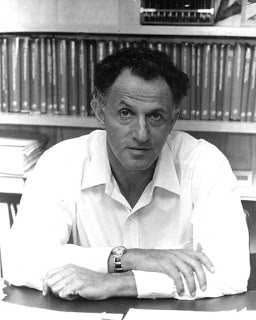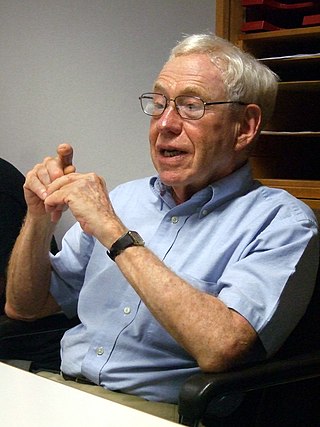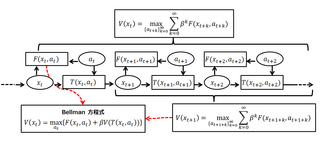
In machine learning, a neural network is a model inspired by the structure and function of biological neural networks in animal brains.

Richard Ernest Bellman was an American applied mathematician, who introduced dynamic programming in 1953, and made important contributions in other fields of mathematics, such as biomathematics. He founded the leading biomathematical journal Mathematical Biosciences, as well as the Journal of Mathematical Analysis and Applications.
The Hamilton-Jacobi-Bellman (HJB) equation is a nonlinear partial differential equation that provides necessary and sufficient conditions for optimality of a control with respect to a loss function. Its solution is the value function of the optimal control problem which, once known, can be used to obtain the optimal control by taking the maximizer of the Hamiltonian involved in the HJB equation.

Hubert Lederer Dreyfus was an American philosopher and a professor of philosophy at the University of California, Berkeley. His main interests included phenomenology, existentialism and the philosophy of both psychology and literature, as well as the philosophical implications of artificial intelligence. He was widely known for his exegesis of Martin Heidegger, which critics labeled "Dreydegger".

A Bellman equation, named after Richard E. Bellman, is a necessary condition for optimality associated with the mathematical optimization method known as dynamic programming. It writes the "value" of a decision problem at a certain point in time in terms of the payoff from some initial choices and the "value" of the remaining decision problem that results from those initial choices. This breaks a dynamic optimization problem into a sequence of simpler subproblems, as Bellman's “principle of optimality" prescribes. The equation applies to algebraic structures with a total ordering; for algebraic structures with a partial ordering, the generic Bellman's equation can be used.
In machine learning, backpropagation is a gradient estimation method commonly used for training a neural network to compute its parameter updates.
Recurrent neural networks (RNNs) are a class of artificial neural network commonly used for sequential data processing. Unlike feedforward neural networks, which process data in a single pass, RNNs process data across multiple time steps, making them well-adapted for modelling and processing text, speech, and time series.

Feedforward refers to recognition-inference architecture of neural networks. Artificial neural network architectures are based on inputs multiplied by weights to obtain outputs (inputs-to-output): feedforward. Recurrent neural networks, or neural networks with loops allow information from later processing stages to feed back to earlier stages for sequence processing. However, at every stage of inference a feedforward multiplication remains the core, essential for backpropagation or backpropagation through time. Thus neural networks cannot contain feedback like negative feedback or positive feedback where the outputs feed back to the very same inputs and modify them, because this forms an infinite loop which is not possible to rewind in time to generate an error signal through backpropagation. This issue and nomenclature appear to be a point of confusion between some computer scientists and scientists in other fields studying brain networks.

Quantum neural networks are computational neural network models which are based on the principles of quantum mechanics. The first ideas on quantum neural computation were published independently in 1995 by Subhash Kak and Ron Chrisley, engaging with the theory of quantum mind, which posits that quantum effects play a role in cognitive function. However, typical research in quantum neural networks involves combining classical artificial neural network models with the advantages of quantum information in order to develop more efficient algorithms. One important motivation for these investigations is the difficulty to train classical neural networks, especially in big data applications. The hope is that features of quantum computing such as quantum parallelism or the effects of interference and entanglement can be used as resources. Since the technological implementation of a quantum computer is still in a premature stage, such quantum neural network models are mostly theoretical proposals that await their full implementation in physical experiments.
Meta-learning is a subfield of machine learning where automatic learning algorithms are applied to metadata about machine learning experiments. As of 2017, the term had not found a standard interpretation, however the main goal is to use such metadata to understand how automatic learning can become flexible in solving learning problems, hence to improve the performance of existing learning algorithms or to learn (induce) the learning algorithm itself, hence the alternative term learning to learn.
Rufus Philip Isaacs was an American game theorist especially prominent in the 1950s and 1960s with his work on differential games.
Recursive economics is a branch of modern economics based on a paradigm of individuals making a series of two-period optimization decisions over time.
Kumpati S. Narendra is an American control theorist, who currently holds the Harold W. Cheel Professorship of Electrical Engineering at Yale University. He received the Richard E. Bellman Control Heritage Award in 2003. He is noted "for pioneering contributions to stability theory, adaptive and learning systems theory." He is also well recognized for his research work towards learning including Neural Networks and Learning Automata.
Arthur Earl Bryson Jr. is the Paul Pigott Professor of Engineering Emeritus at Stanford University and the "father of modern optimal control theory". With Henry J. Kelley, he also pioneered an early version of the backpropagation procedure, now widely used for machine learning and artificial neural networks.

Deep learning is a subset of machine learning that focuses on utilizing neural networks to perform tasks such as classification, regression, and representation learning. The field takes inspiration from biological neuroscience and is centered around stacking artificial neurons into layers and "training" them to process data. The adjective "deep" refers to the use of multiple layers in the network. Methods used can be either supervised, semi-supervised or unsupervised.
Joseph Pierre LaSalle was an American mathematician specialising in dynamical systems and responsible for important contributions to stability theory, such as LaSalle's invariance principle which bears his name.
Henry J. Kelley (1926-1988) was Christopher C. Kraft Professor of Aerospace and Ocean Engineering at the Virginia Polytechnic Institute. He produced major contributions to control theory, especially in aeronautical engineering and flight optimization.
This glossary of artificial intelligence is a list of definitions of terms and concepts relevant to the study of artificial intelligence (AI), its subdisciplines, and related fields. Related glossaries include Glossary of computer science, Glossary of robotics, and Glossary of machine vision.

In artificial intelligence, a differentiable neural computer (DNC) is a memory augmented neural network architecture (MANN), which is typically recurrent in its implementation. The model was published in 2016 by Alex Graves et al. of DeepMind.
Artificial neural networks (ANNs) are models created using machine learning to perform a number of tasks. Their creation was inspired by biological neural circuitry. While some of the computational implementations ANNs relate to earlier discoveries in mathematics, the first implementation of ANNs was by psychologist Frank Rosenblatt, who developed the perceptron. Little research was conducted on ANNs in the 1970s and 1980s, with the AAAI calling this period an "AI winter".







